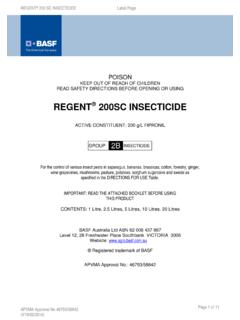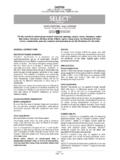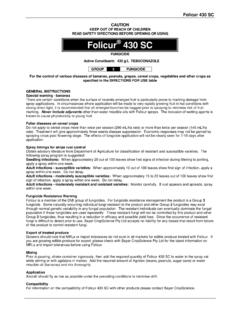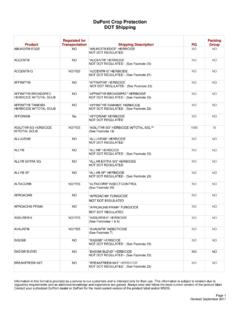Transcription of DuPont Steward EC insecticide label - HerbiGuide
1 DuPont Steward EC insecticide Technical Information Active Constituent: 150 g/L INDOXACARB GROUP 22A insecticide Pack Sizes: 10 L, 200 L POISON KEEP OUT OF REACH OF CHILDREN READ SAFETY DIRECTIONS BEFORE OPENING OR USING For the control of various species of insect pests in Azuki beans, Chickpeas, Cotton, Faba beans, Mungbeans and Soybeans as per the Directions for Use SAFETY DIRECTIONS Harmful if swallowed. Will irritate the eyes and skin. Avoid contact with eyes and skin. Repeated exposure may cause allergic disorders. Sensitive workers should use protective clothing. When opening the container, preparing spray and using the prepared spray, wear cotton overalls buttoned to the neck and wrists, a washable hat and elbow-length PVC gloves. Wash hands after use.
2 After each day s use wash, gloves and contaminated clothing. FIRST AID If poisoning occurs, contact a doctor or Poisons Information Centre. Phone Australia 13 11 26. MATERIAL SAFETY DATA SHEET Additional information is listed in the Material Safety Data Sheet. GENERAL INSTRUCTIONS DuPont Steward EC insecticide is an emulsifiable concentrate formulation. DuPont Steward EC insecticide should be applied after careful field monitoring of pest populations of eggs and larvae to determine the need for application, the correct timing of the initial application and of any subsequent applications. For Cotton only, subsequent applications are dependent on economic thresholds, as well as the growth rate of new unprotected cotton terminals. For Helicoverpa species, spray applications should be timed to coincide with egg hatching and before larvae are entrenched in protected feeding sites.
3 Steward EC has been specifically designed for use in Integrated Pest Management schemes. The active ingredient, indoxacarb enters larvae primarily by ingestion of treated foliage, or through penetration of the insect cuticle. After ingesting indoxacarb, the larvae cease feeding and die three to five days later. Steward EC does not give traditional larval knockdown control but controls nominated larvae species giving superior: - square, flower and boll protection in cotton OR - foliage, flower and pod protection in Chickpea, Faba beans, Mungbeans or Soybeans. insecticide RESISTANCE WARNING For insecticide resistance management DuPont Steward insecticide is a Group 22A insecticide . Some naturally occurring insect biotypes resistant to DuPont Steward and other Group 22A insecticides may exist through normal genetic variability in any insect population.
4 The resistant individuals can eventually dominate the insect population if DuPont Steward or other Group 22A insecticides are used repeatedly. The effectiveness of DuPont Steward on resistant individuals could be significantly reduced. Since occurrence of resistant individuals is difficult to detect prior to use, DuPont accepts no liability for any losses that may result from the failure of [trade name] to control resistant insects. Strategies to minimise the risk of insecticide resistance are available. To help prevent the development of resistance to Steward EC insecticide observe the following instructions: Use Steward EC in accordance with the current insecticide Resistance Management (IRM) strategy for your region. Cultivate all cotton fields as soon as possible after picking to destroy overwintering pupae of Helicoverpa armigera.
5 For further information contact your local supplier, DuPont representative or local agricultural department agronomist. GROUP 22A insecticide 59573/0609 DuPont Steward EC insecticide Page 1 of 4 PRODUCT USE The interaction of equipment and weather-related factors determines the potential for spray drift. The applicator must consider all these factors when making application decisions and determining off-target drift risks near the application. A spray drift minimisation strategy, should be employed at all times when applying this product. APPLYING LARGER DROPLETS (volume median diameter (VMD) 150-250 microns) REDUCES DRIFT POTENTIAL, BUT WILL NOT MINIMISE DRIFT IF APPLICATIONS ARE MADE IMPROPERLY OR UNDER UNFAVOURABLE ENVIRONMENTAL CONDITIONS.
6 Larger droplets may reduce the effects of evaporation. Mixing Use only clean water. Half fill the spray tank with water and add the appropriate amount of Steward EC directly to the spray tank, agitate and add Ovasyn or amitraz 200 g/L EC, (if applicable), then completely fill the tank. Mix thoroughly and continue mechanical or hydraulic agitation. Storage of spray mixture Use the prepared spray immediately. If unforeseen conditions prevent immediate use of the Steward EC spray mix, the mix may be stored up to 72 hours. Before use, thoroughly agitate the spray mix until fully resuspended. Mixtures of Steward EC plus Ovasyn* or Amitraz 200 g/L EC should not be stored. Application Application equipment should be calibrated to apply at least sixty (60) droplets per cm2 of target foliage.
7 Droplet VMD should be of medium spray quality according to ASAE S572 definition for standard nozzles. Ground application Apply as a blanket spray or as a banded spray to all crops. Ensure thorough spray coverage on the foliage, using appropriate fan nozzles. Apply in a minimum spray volume of 100 L/ha and keep the boom low to avoid spray drift. A minimum spray pressure of 275 kPa (40 psi) should be used with fan nozzles applying insecticides. Higher pressure reduces droplet size, DOES NOT improve canopy penetration and may increase drift potential. WHEN HIGHER FLOW RATES ARE NEEDED, USE A HIGHER-CAPACITY NOZZLE INSTEAD OF INCREASING PRESSURE. For band spraying, increase the number of fan nozzles per crop row as the plant size increases. Aerial application Steward EC must only be applied with aircraft fitted with accurately calibrated equipment.
8 Apply a minimum total spray volume of 30 L/ha with nozzles ( Micronaire rotary atomisers, CP nozzles or conventional hydraulic nozzles) set to medium spray quality according to ASAE S572 definition for standard nozzles. A spray drift minimisation strategy, should be employed at all times when applying this product. DO NOT apply Steward EC using Ultra Low Volume (ULV) methods. Compatibility: label instructions for all products must be observed Steward EC is compatible with Ovasyn* insecticide , Amitraz* 200 g/L EC formulations and Pix* (mepiquat chloride). Steward EC is not compatible with ultra low volume (ULV) formulations or the following foliar fertilisers: Supa* K 30, Zip* and Triple 7*. Since formulations may be changed and new ones introduced, it is recommended that users pre-mix a small quantity of the desired tankmix and observe possible adverse changes (settling out, flocculation etc).
9 Salt When the addition of salt is indicated in the Directions for Use table, DuPont recommends the use of salt from the following sources: Table or cooking salt, Pool salt, or salt approved for use in livestock feed Cheetham* RAM ( ) Dried Fine Salt, Olsson s* Kiln Dried Course Refined Salt. Spray Equipment Cleanout Only apply product using clean, well maintained equipment. Immediately following application, thoroughly clean all spray equipment to reduce risk of deposits forming that might become difficult to remove. Drain spray equipment into a disposal pita designed for this purpose. Thoroughly rinse sprayer and flush hoses, boom, and nozzles with clean water. Fill the sprayer with clean water and household ammonia (one litre of 3 % active for every 100 L of water).
10 Flush hoses, boom, and nozzles. Turn off boom and top off the tank with clean water. Circulate through the spraying system for at least 15 minutes. Flush the hoses, boom and nozzles and drain the tank. Remove and clean nozzles, screens, and strainers in a bucket of fresh ammonia and water. Thoroughly rinse the sprayer, hoses, boom and nozzles with clean water several times. Clean all other associated contaminated application equipment. PROTECTION OF LIVESTOCK Dangerous to bees. DO NOT apply when bees are actively foraging. Avoid direct application or drift of the spray mix onto beehives. After the spray has dried, bees can safely forage flowering crops. AVOID SPRAY DRIFT ONTO ADJOINING PROPERTIES OR STOCK AREAS. Assess the treatment area before application to identify animal exposure risks.











